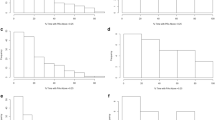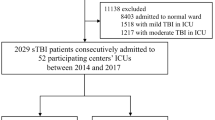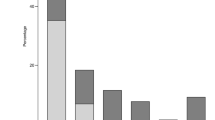Abstract
This study evaluates the outcome of 56 severely brain injured children (mean age 6.2±2.1 years) and relates the Initial Glasgow Coma Scale (IGCS), initial intracranial pressure (ICP int), maximal intracranial pressure (ICP max) and minimal cerebral perfusion pressure (CPP min) to quality of survival. Forty-one children sustained head trauma, five severe central nervous system infections and 10 were of miscellaneous etiology. Therapy consisted of mechanical hyperventilation, moderate fluid restriction, dexamethasone and diagnosis specific measures when indicated. Outcome was categorized according to the Glasgow outcome scale at discharge from the hospital. An IGCS of 3 was associated with 100% mortality, 7 and above resulted in 72% good recovery, 28% poor outcome and no mortality. ICP int of less than 20 torr was noted in (67%) of the patients, and did not correlate with ICP max or outcome. Conversely, ICP int in excess of 40 torr correlated well with ICP max and outcome. ICP max of less than 20 torr resulted in 57% good recovery, 36% poor outcome and 7% mortality. ICP max greater than 40 torr resulted in 7% poor outcome and 93% mortality (p<0.001). In head trauma, 32 patients (78%) were alive with mean ICP max 16.9±3.1 and CPP min 65.5±8.5 torr compared to 9 patients (22%) who died with mean ICP max 53.7±10.8 and CPP min 6±3.9 torr, (p<0.01). In children with infectious etiology 60% survived with mean ICP max 16±3 and CPP min 96±16 torr. Forty percent died with ICP max 39±21 and CPP min 65±35 torr. In patients with brain injury of miscellaneous etiology, 60% lived with mean ICP max 17.3±6.2 and CPP min 75±13.4 torr, 40% died with mean ICP max 45.6±7.8 and CPP min 23.3±9.4 torr. Our results indicate favorable outcome in head trauma patients and stress the overall importance of aggressive ICP control and optimal maintenance of cerebral perfusion pressure. The same does not imply in CNS infection, since a mean CPP min of 65±35 torr in non survivors did not affect outcome.
Similar content being viewed by others
References
Bruce DA, Schut L, Bruno AL, Wood JH, Sutton LN (1978) Outcome following severe head injuries in children. J Neurosurg 48:679
Saul GT, Ducker BT (1982) Effect of intracranial pressure monitoring and aggressive treatment on mortality in sever head injury. J Neurosurg 56:498
Bowers SA, Marshall LF (1980) Outcome in 200 consecutive cases of severe head injury treated in San Diego County: a prospecitive analysis. Neurosurg 6:237
Bruce DA, Raphaely RC, Goldberg AI, Zimmerman RA, Bilaniuk LT, Schut L, Kuhl DE (1979) Pathophysiology, treatment and outcome following severe head injury in children. Child's Brain 5:174
Bruce DA, Berman WA, Schut L (1977) Cerebral fluid pressure monitoring in children: physiology, pathology and clinical usefulness. In: Barness L (ed) Advances in pediatrics. Yearbook Medical Publishers, Chicago, p 233
Miller JD, Butterworth JF, Gudeman SK, Faulkner JE, Choi SC, Selhorst JB, Harbison JW, Lutz HA, Young HF, Becker DP (1981) Further experience in the management of severe head injury. J Neurosurg 54:289
Shapiro HM (1975) Intracranial hypertension: therapeutic and anesthetic considerations. Anesthesiology 43:445
Goitein KJ, Tamir I (1983) Cerebral perfusion pressure in CNS infections of infancy and childhood. J Pediatr 103:40
Nugent SK, Bausher JA, Moxon ER, et al (1979) Raised intracranial pressure: its management in neisseria meninigitidis meningoencephalitis. Am J Dis Child 133:260
De Long GR, Glick TH (1982) Encephalopathy of Reye's Syndrome: a review of pathogenetic hypotheses. Pediatrics 69:53
Fraser CL, Ariefe AI (1985) Hepatic encephalopathy. N Engl J Med 313:859
Ariefe AI (1986) Hyponatremia, convulsions, respiratory arrest, and permanent brain damage after elective surgery in healthy women. N Engl J Med 314:1529
Lassen HA (1974) Control of cerebral circulation in health and disease. Circ Res 34:749
Teasdale G, Jennett B (1974) Assessment of coma and impaired consciousness: a practical scale. Lancet II:81
Jennett B, Bond M (1975) Assessment of outcome after severe brain damage: a practical scale. Lancet I:480
Miller JD, Becker D, Ward J, et al (1977) Significance of intracranial hypertension in severe head injury. J Neurosurg 47:503
Becker D, Miller JD, Ward J, Greenberg RP, Young HF, Sakalas R (1977) The outcome from severe head injury with early with early diagnosis and intensive management. J Neurosurg 47:491
Goitein KJ, Fainmesser P, Shomer H (1983) Cerebral perfusion pressure and auditory brain stem responses in childhood CNS diseases. Am J Dis Child 137:777
Klauber MR, Barrett-Connor E, Marshall LF, et al (1981) The epidemiology of head injury: a prospective study of an entire community — San Diego County, California 1978. Am J Epidemiol 113:500
Kraus JF, Black MA, Hessol N, Ley P, Rokaw W, Sullivan L, Bowers S, Knowlton S, Marshall L (1984) The incidence of acute brain injury and serious impairment in a defined population. Am J Epidemiol 119:186
Fife D, Faich G, Hollinshead W, Boynton W (1986) Incidence and outcome of hospital treated head injury in Rhode Island. Am J Public Health 76:773
Grosswasser Z, Costeff H, Tamir A (1985) Survivors of severe traumatic brain injury in childhood I. Incidence, background and hospital course. Scand J Rehabil Med (Suppl) 12:6
Mickell JJ, Reigel DH, Cook DR, Binda RE, Safar P (1977) Intracranial pressure: monitoring and normalization therapy in children. Pediatrics 59:606
ean JM, McComb JG (1981) Intracranial pressure monitoring in severe pediatric near-drowning. Neurosurg 9:627
Williams CPS, Swanson AG, Chapman JT (1964) Brain swelling with acute purulent menigitis: report of treatment with hypertonic intravenous urea. Pediatrics 34:220
Heisted DD, Kontos HA (1983) Cerebral circulation. In: Shepard JT, Abboud FM, (eds) Handbook of Physiology — the cardiovascular system, II, Vol 3: Peripheral circulation and organ blood flow. Williams and Wilkins, Baltimore, p 137
Miller JD, Stanek A, Langfitt TW (1972) Concepts of Cerebral perfusion pressure and vascular compression during intracranial hypertension. In: Meyer JS, Schmede JP (eds) Progress in brain research. Elsevier, Amsterdam, p 411
Wagner EM, Traystman RJ (1986) Hydrostatic determinants of cerebral perfusion. Crit Care Med 14:484
Gruszkiewicz J, Doron Y, Peyser E (1973) Recovery from severe craniocerebral injury and brain stem lesions in childhood. Surg Neurol 1:197
Hendrick EB (1959) The use of hypothermia in severe head injury in childhood. Arch Surg 79:362
Bricolo A, Turazzi S, Alexandre A, Rizzuto N (1977) Decerebrate regidity in acute head injury. J Neurosurg 47:680
Author information
Authors and Affiliations
Rights and permissions
About this article
Cite this article
Barzilay, Z., Augarten, A., Sagy, M. et al. Variables affecting outcome from severe brain injury in children. Intensive Care Med 14, 417–421 (1988). https://doi.org/10.1007/BF00262899
Received:
Accepted:
Issue Date:
DOI: https://doi.org/10.1007/BF00262899




